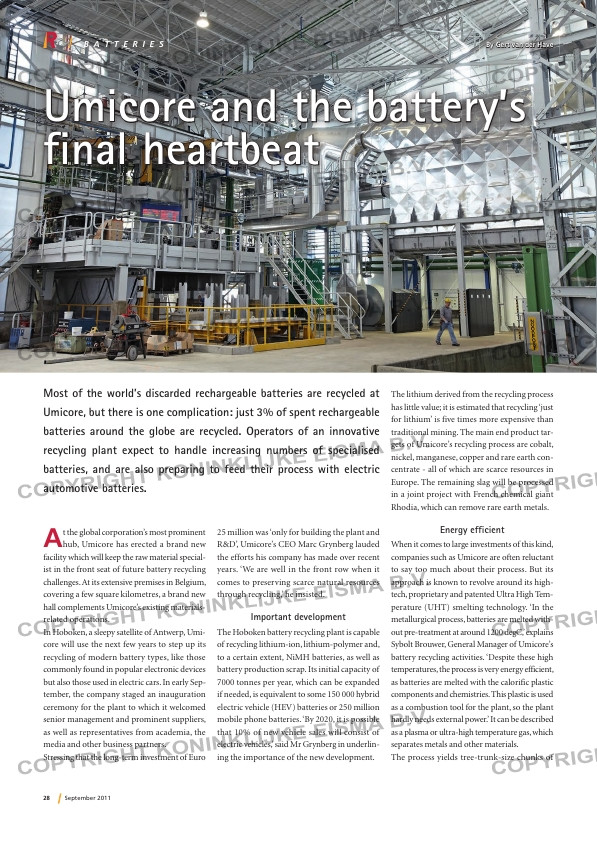Page 28 from: September 2011

28 September 2011
Umicore and the battery’s
final heartbeat
Most of the world’s discarded rechargeable batteries are recycled at
Umicore, but there is one complication: just 3% of spent rechargeable
batteries around the globe are recycled. Operators of an innovative
recycling plant expect to handle increasing numbers of specialised
batteries, and are also preparing to feed their process with electric
automotive batteries.
At the global corporation’s most prominent hub, Umicore has erected a brand new
facility which will keep the raw material special-
ist in the front seat of future battery recycling
challenges. At its extensive premises in Belgium,
covering a few square kilometres, a brand new
hall complements Umicore’s existing materials-
related operations.
In Hoboken, a sleepy satellite of Antwerp, Umi-
core will use the next few years to step up its
recycling of modern battery types, like those
commonly found in popular electronic devices
but also those used in electric cars. In early Sep-
tember, the company staged an inauguration
ceremony for the plant to which it welcomed
senior management and prominent suppliers,
as well as representatives from academia, the
media and other business partners.
Stressing that the long-term investment of Euro
25 million was ‘only for building the plant and
R&D’, Umicore’s CEO Marc Grynberg lauded
the efforts his company has made over recent
years. ‘We are well in the front row when it
comes to preserving scarce natural resources
through recycling,’ he insisted.
Important development
The Hoboken battery recycling plant is capable
of recycling lithium-ion, lithium-polymer and,
to a certain extent, NiMH batteries, as well as
battery production scrap. Its initial capacity of
7000 tonnes per year, which can be expanded
if needed, is equivalent to some 150 000 hybrid
electric vehicle (HEV) batteries or 250 million
mobile phone batteries. ‘By 2020, it is possible
that 10% of new vehicle sales will consist of
electric vehicles,’ said Mr Grynberg in underlin-
ing the importance of the new development.
The lithium derived from the recycling process
has little value; it is estimated that recycling ‘just
for lithium’ is five times more expensive than
traditional mining. The main end product tar-
gets of Umicore’s recycling process are cobalt,
nickel, manganese, copper and rare earth con-
centrate – all of which are scarce resources in
Europe. The remaining slag will be processed
in a joint project with French chemical giant
Rhodia, which can remove rare earth metals.
Energy efficient
When it comes to large investments of this kind,
companies such as Umicore are often reluctant
to say too much about their process. But its
approach is known to revolve around its high-
tech, proprietary and patented Ultra High Tem-
perature (UHT) smelting technology. ‘In the
metallurgical process, batteries are melted with-
out pre-treatment at around 1200 degC,’ explains
Sybolt Brouwer, General Manager of Umicore’s
battery recycling activities. ‘Despite these high
temperatures, the process is very energy efficient,
as batteries are melted with the calorific plastic
components and chemistries. This plastic is used
as a combustion tool for the plant, so the plant
hardly needs external power.’ It can be described
as a plasma or ultra-high temperature gas, which
separates metals and other materials.
The process yields tree-trunk-size chunks of
B A T T E R I E S By Gert van der Have
028 m o 28 12-0 -11 1 :1



